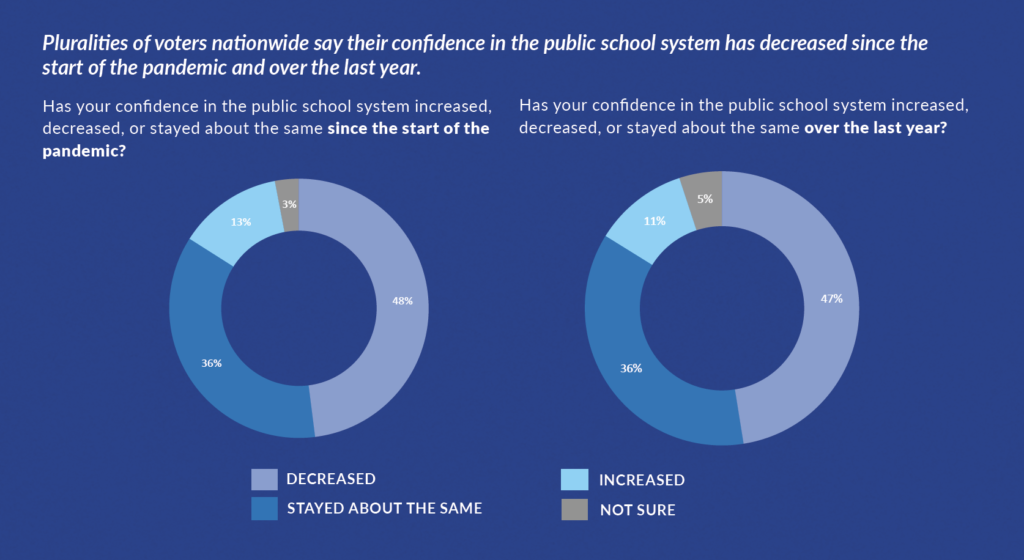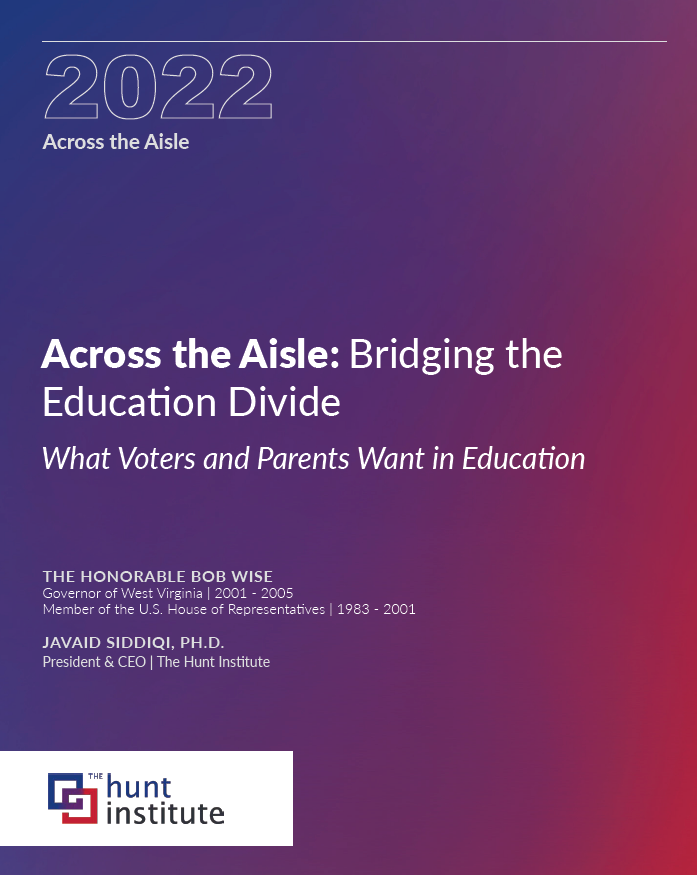Across the Aisle Report 2022: What Voters and Parents Want in Education
November 1, 2022
Last year, as states and districts across the country grappled with academic and social and emotional learning loss, states and districts were still in a state of triage, learning about the full impacts of school closures while supporting students and educators with safely returning to school. Furthermore, parents were anxious about when and how things would return to a state of normalcy. This context laid the groundwork for The Hunt Institute’s 2021 Emerging Priorities for Education Leaders Report to better understand the educational challenges and issues that are top of mind among the public.
One year later, how have public priorities changed?
America’s ever-changing educational landscape inspired The Hunt Institute to explore whether parent and voter priorities had shifted since our last report was published. In partnership with Lake Research Partners, we conducted an updated nationwide survey of parents and voters to hear their concerns, gauge their priorities, and establish a path forward for transforming our education system for the better. With support from the Carnegie Corporation of New York, The Hunt Institute is pleased to present our updated 2022 report, Across the Aisle: Bridging the Education Divide, What Voters and Parents Want in Education.
From our 2022 nationwide survey of parents and voters, we learned that:
Voters nationwide are losing confidence in our public school system. Nearly 5 in 10 voters say their confidence in the public school system has decreased since the start of the pandemic (48 percent) and over the past year (47 percent). These findings reflect those of other reputable polls that indicate similar trends in declining public confidence. In addition, only about a quarter of parents believe school district officials (26 percent), state education leaders (26 percent), and school board members (24 percent) handled the impacts of COVID-19 very well.
Recent hot-button issues such as book banning and censoring curriculum have dominated media headlines but are largely unpopular. About 7 in 10 voters (68 percent) and 6 in 10 parents (60 percent) believe book banning and curriculum censorship is a problem. In addition, compared to other issues provided in the survey, it is among the lowest ranked priorities for policymakers to address.
Voters believe that students need more than just a foundation in core subjects and that our schools need to be teaching real-world skills for the future workforce. In fact, nearly half of voters (48 percent) believe that not teaching real-world skills for the future workforce is a very big problem in public education today. Voters also strongly favored proposals that call for teaching critical skills for the workplace in schools (65 percent) and increasing job skills and workforce training opportunities in high school, such as apprenticeships and internship opportunities (64 percent).
School safety in particular is a high priority issue in the eyes of voters and parents. With high-profile school shootings in recent years, a majority of voters and parents continue to see school safety as an issue across several fronts. Voters and parents prioritize addressing school safety, and especially addressing gun violence in our schools – even more so than issues around school choice, digital access, or standardized testing. Three in four voters (75 percent) believe that guns and other physical violence in schools is a problem, and a similar number (73 percent) believe bullying, including cyber bullying, in schools is a problem.
Voters look to additional mental health support as a necessary part of recovery efforts. Over half of voters (51 percent) strongly favored investing in student’s individual needs, including their social and emotional learning (SEL) needs. Notably, strong favorability increased for nearly all parent, political party, and racial subgroups when SEL language was included, showing that it is not the dog-whistle term that has been portrayed in the media.
One year later, learning loss remains a high priority issue for parents and voters, with special attention paid to literacy. Seventy percent of voters believe that learning loss is currently a problem, and 40 percent believe that it is a very big problem. Additionally, voters across party lines acknowledged the socioeconomic inequities that were exacerbated by the pandemic, with 82 percent of democrats, 72 percent of independents, and 61 percent of republicans agreeing that COVID-19 widened the learning gap between students from low-income and high-income families. Early literacy in particular is a key issue among the public with 70 percent of voters identifying students reading at grade level as very important.
With just 16.7 percent of ESSER III dollars spent as of August 2022, according to Georgetown University’s Edunomics Lab, there are still billions of untapped dollars left for bold educational investments before the shrinking two-year deadline is up. On top of ESSER dollars, $350 billion in Coronavirus State and Local Fiscal Recovery Funds (SLFRF) and portions of the 2021 Infrastructure Investment and Jobs Act funding, among other funding streams, can go toward programs and initiatives to support student mental health, community wraparound services, workforce training, and digital access.
States and district policymakers have a once-in-a-lifetime opportunity to turn things around over the next two years and bringing public and parent voices to the table will be critical to establishing buy-in and regaining public trust. The Hunt Institute’s survey results can serve as a point for further discussion on how states and districts can thoughtfully and intentionally allocate their time-limited funding.
Read more about our findings and next steps for states and districts over the next two years in The Hunt Institute’s Across the Aisle Report, co-authored by The Hunt Institute’s President and CEO Dr. Javaid Siddiqi, and former West Virginia governor and member of the U.S. House of Representatives, Bob Wise. View the slide deck for additional survey findings.





